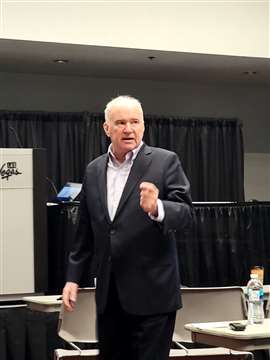Leading economist: US economy to weaken in first half of 2024
24 January 2024
Ed Sullivan, a leading economist for the concrete and construction industries, spoke about the Portland Cement Association’s 2024 financial forecast, predicting a temporary downturn in the first half of this year, followed by recovery in the second half and, importantly, no sign of a recession. Here are some highlights from the press conference held at World of Concrete in Las Vegas on Jan. 23.
 Ed Sullivan, chief economist with Portland Cement Association, said he sees no recession for the US economy this year. (Photo: KHL)
Ed Sullivan, chief economist with Portland Cement Association, said he sees no recession for the US economy this year. (Photo: KHL)
The US economy will gradually weaken during the first half of 2024, but will likely recover slowly in the second half.
That’s according to Ed Sullivan, chief economist and senior vice president of market intelligence for the Portland Cement Association (PCA), who presented the association’s annual forecast at World of Concrete in Las Vegas on Jan. 23.
Sullivan explained some of the determining factors for this year’s forecast include the end of the Covid-19 relief programs, lingering impacts of monetary policy and credit tightening.
It was noted that over the past year, the Federal Reserve has responded to rising inflation with the largest rate increases in more than 40 years. Inflation peaked in 2022 and appears to be improving currently.
Since the Fed starting raising rates, more than 7 million net new jobs have been created, according to the US Cement Outlook, released in October 2023.
All things considered, despite an expected economic slowdown, the chance of a recession this year is unlikely, Sullivan stated.
“We expected a weakening,” he said, adding, “The economy is strong.”
“In terms of the construction outlook, there will be a battle between interest-sensitive construction sectors and less-interest-sensitive construction activity, such as infrastructure spending and the construction of large manufacturing plants associated with the CHIPS act,” Sullivan said.
Also vital to the construction industry this year is business driven by the Infrastructure Investment and Jobs Act (IIJA), which represents $550 billion in new infrastructure spending. Unlike previous funding mechanisms for infrastructure, like the American Recovery and Reinvestment Act of 2009, the entire IIJA package is dedicated to revamping infrastructure.
Since it was signed into law in 2021, the Biden-Harris Administration says some 40,000 IIJA projects are underway or have been completed. A total of 2.6 million jobs have been created over the past year.
“[IIJA] is expected to show up in a more meaningful way this year and next,” Sullivan predicted.
The scope of funding is broad based, with spending on traditional infrastructure such as roads, bridges, airports, rail, water, and sewer systems. There are also generous spending levels for things like resiliency projects and legacy pollutions, broadband internet, and the energy grid.
“The president is right to tout IIJA’s success on the campaign trail — as it was considered an authentically bipartisan bill and has picked up its stride since being launched more than two years ago,” said Mike Ireland, PCA president and CEO.
“Our industries hope the Administration, to include the Environmental Protection Agency, will work with cement and concrete manufacturers to determine the most feasible strategies for us to continue to supply the resilient, sustainable construction materials for infrastructure that the country has come to expect,” Ireland said.
STAY CONNECTED



Receive the information you need when you need it through our world-leading magazines, newsletters and daily briefings.
CONNECT WITH THE TEAM









